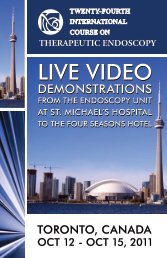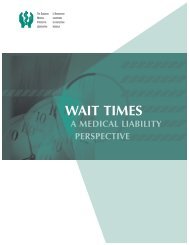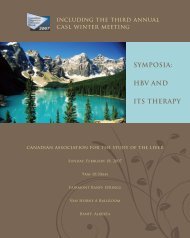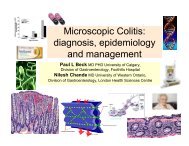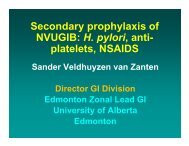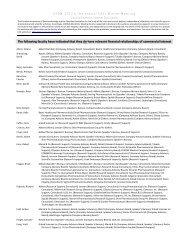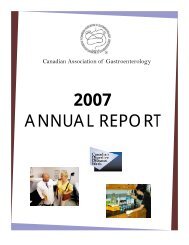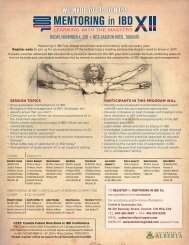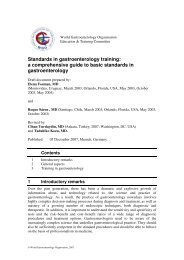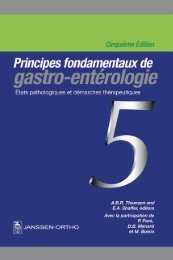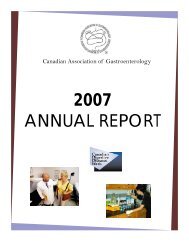Manifestations of Gastrointestinal Disease in the Child
Manifestations of Gastrointestinal Disease in the Child
Manifestations of Gastrointestinal Disease in the Child
You also want an ePaper? Increase the reach of your titles
YUMPU automatically turns print PDFs into web optimized ePapers that Google loves.
726 FIRST PRINCIPLES OF GASTROENTEROLOGY<br />
7.2 Physiological Jaundice<br />
A mild hyperbilirub<strong>in</strong>emia is seen <strong>in</strong> nearly all newborns but resolves usually<br />
with<strong>in</strong> <strong>the</strong> first two weeks after birth. This is always unconjugated and<br />
<strong>the</strong> rate <strong>of</strong> rise <strong>of</strong> bilirub<strong>in</strong> should be no greater than 85 micromolar per<br />
day. Peak levels <strong>of</strong> bilirub<strong>in</strong> rarely exceed 150 micromolar <strong>in</strong> term <strong>in</strong>fants.<br />
Several mechanisms contribut<strong>in</strong>g to development <strong>of</strong> physiological jaundice<br />
are outl<strong>in</strong>ed <strong>in</strong> Table 11.<br />
The shorter half life <strong>of</strong> <strong>the</strong> neonate’s red blood cells and a more rapid<br />
turnover, along with <strong>the</strong> relatively high hematocrit, result <strong>in</strong> an <strong>in</strong>creased production<br />
<strong>of</strong> bilirub<strong>in</strong>. There is also a decreased clearance <strong>of</strong> bilirub<strong>in</strong> because<br />
<strong>of</strong> lower activity <strong>of</strong> <strong>the</strong> urid<strong>in</strong>e glucuronyl transferase (UGT), <strong>the</strong> enzyme<br />
which is <strong>in</strong>volved <strong>in</strong> conjugation. Meconium has high levels <strong>of</strong> bilirub<strong>in</strong> and<br />
<strong>the</strong>re are decreased enteric bacteria which usually transform <strong>the</strong> conjugated<br />
bilirub<strong>in</strong> to urobil<strong>in</strong>ogen. The presence <strong>of</strong> <strong>in</strong>test<strong>in</strong>al ß-glucuronidase results <strong>in</strong><br />
greater transformation <strong>of</strong> conjugated back to unconjugated bilirub<strong>in</strong>. This<br />
form <strong>of</strong> bilirub<strong>in</strong> may be <strong>the</strong>n reabsorbed back <strong>in</strong>to <strong>the</strong> circulation via <strong>the</strong><br />
enterohepatic circulation.<br />
Genetic variations lead to <strong>in</strong>creased susceptibility to jaundice <strong>in</strong> various<br />
ethnic groups.<br />
7.3 Pathological Jaundice<br />
Potentially life-threaten<strong>in</strong>g illnesses may present with jaundice <strong>in</strong> <strong>the</strong> neonatal<br />
period so it is very important to dist<strong>in</strong>guish between physiological and pathological<br />
jaundice. The follow<strong>in</strong>g features would suggest pathological jaundice<br />
which would need to be <strong>in</strong>vestigated:<br />
1. Jaundice appear<strong>in</strong>g <strong>in</strong> <strong>the</strong> first 24 hours<br />
2. Rate <strong>of</strong> rise <strong>of</strong> bilirub<strong>in</strong> <strong>of</strong> greater than 85 micromoles/litre/day<br />
(3.54 micromoles /litre/hour)<br />
3. Serum total bilirub<strong>in</strong> greater than <strong>the</strong> hour-specific 95th percentile<br />
4. Conjugated bilirub<strong>in</strong> <strong>of</strong> greater than 34 micromolar or > 15% <strong>of</strong> total bilirub<strong>in</strong><br />
5. Persistence <strong>of</strong> jaundice beyond two weeks <strong>of</strong> age<br />
The first step <strong>in</strong> evaluat<strong>in</strong>g a jaundiced <strong>in</strong>fant is to determ<strong>in</strong>e <strong>the</strong> total and<br />
conjugated bilirub<strong>in</strong> concentrations.<br />
7.3.1 UNCONJUGATED HYPERBILIRUBINEMIA<br />
Jaundice is caused by ei<strong>the</strong>r an <strong>in</strong>creased production or decreased clearance <strong>of</strong><br />
bilirub<strong>in</strong> by <strong>the</strong> liver. The causes <strong>of</strong> pathological unconjugated bilirub<strong>in</strong>emia<br />
are outl<strong>in</strong>ed <strong>in</strong> Table 12. The most common cause <strong>of</strong> <strong>in</strong>creased bilirub<strong>in</strong><br />
production is <strong>the</strong> <strong>in</strong>creased red blood cell breakdown seen <strong>in</strong> hemolytic disease



